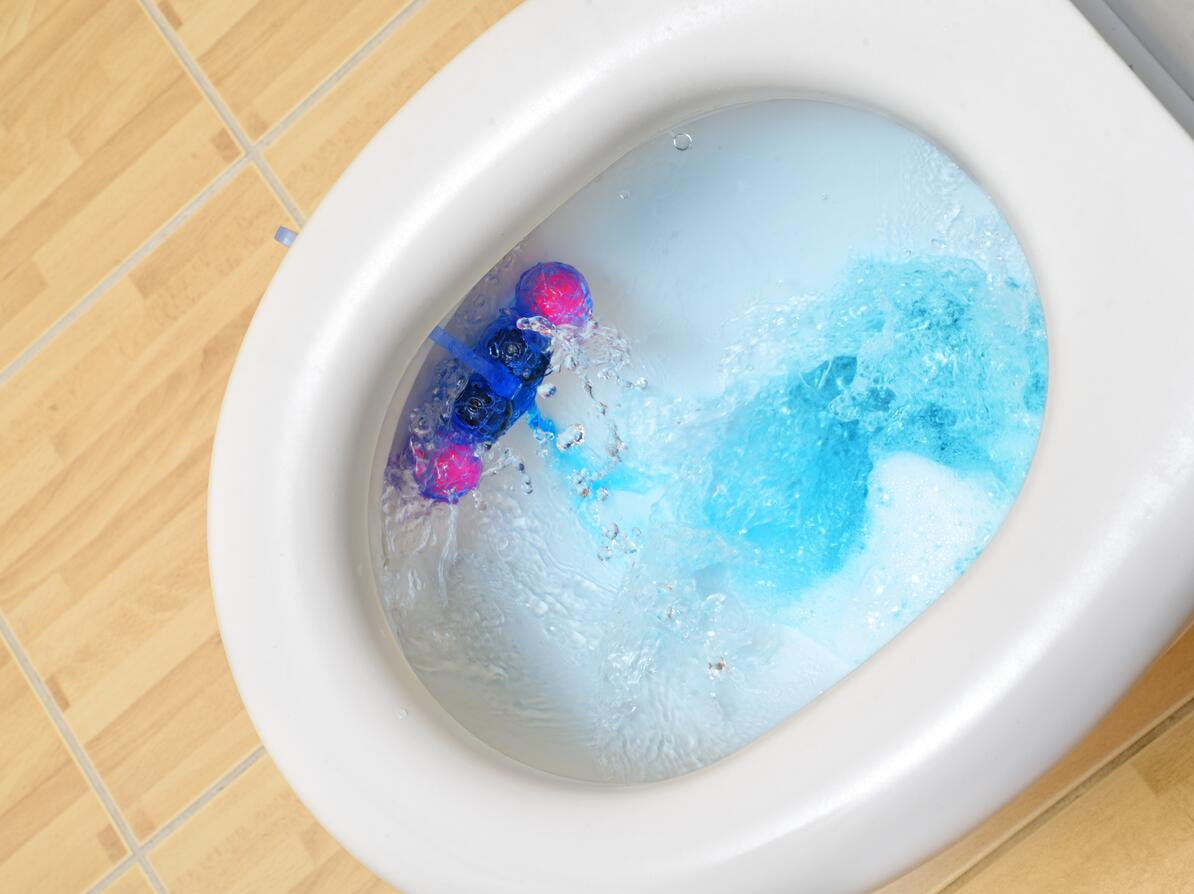These unwanted chemicals are present in toilet blocks
All 45 toilet blocks contained perfume in a recent test from the Danish Consumer Council THINK Chemicals. We also found environmentally harmful substances that cause problems in wastewater treatment plants.

With every flush, fragrant substances from the toilet block are released, spreading scents such as lavender, citrus, etc., throughout your bathroom. Scents that are often associated with cleanliness and good hygiene.
These fragrances and other substances in toilet blocks can have undesirable effects on your health and the environment. The Danish Consumer Council THINK Chemicals has tested 45 toilet blocks for unwanted chemicals for health and environmental concerns.
Toilet blocks are filled with perfume
All toilet blocks in the test contain perfume or fragrance substances, and this is not surprising. The main purpose of toilet blocks is to spread a pleasant scent in the bowl. Perfume and fragrance substances from toilet blocks linger in the air in your bathroom, much like an air freshener in a car or elsewhere in the home. According to the Danish Environmental Protection Agency, air fresheners burden indoor air quality and are suspected of causing hypersensitivity and irritation in the airways.
Therefore, it is a good idea to consider whether you want to limit your exposure and stop using toilet blocks. You can also keep an eye out for any irritation, itching, red eyes, etc., from toilet blocks in the bathroom.
Several problematic chemicals
In addition to perfume and fragrance substances, we find a range of problematic chemicals in 15 toilet blocks, which receive the lowest test score, C-rating. These include substances suspected of being endocrine disrupting, damaging the body's organs, or harming fertility.
We also find the preservatives isothiazolinones, a group of chemicals that are both allergenic and problematic for the environment. They are commonly used in cleaning products and paints, among other product groups. We find benzisothiazolinone, methylchloroisothiazolinone, and methylisothiazolinone in several toilet blocks in the test.
Toilet blocks can be problematic for the environment
In the test, 26 toilet blocks contain the substance group LAS (Linear alkylbenzene sulphonates), which is a group of synthetic substances also found in detergents.
The Danish Environmental Protection Agency has previously urged manufacturers to phase out LAS because these substances can accumulate in oxygen-deprived environments, making them problematic for the environment.
However, these substances are widespread in toilet blocks, and when you flush LAS down the toilet, the substances end up in the treatment plant, where they can cause problems. If there is too much LAS in the sludge at the treatment plant, it can prevent the sludge from being reused, for example, fertilizer on fields.
Many toilet blocks are corrosive
Most of the toilet blocks can be corrosive, as indicated by a corrosive hazard symbol. Always remember to read the label and follow the instructions.
Use unscented toilet cleaner instead
For health and environmental reasons, it is better to use unscented toilet cleaner when cleaning the toilet bowl. Also, look for ecolabelled products.
About the test
-
Ambi Pur, At home, Brait, Bref, Coop, Domestos, Duck, Harpic, Klorin, Mr. Strong, Shine, Sterling and Xtra.
-
In the test, 15 toilet blocks receive the lowest test score, C, because they contain various problematic chemicals.
These are:
- Diethanolamine, which can damage the body's organs.
- Dimethylol glycol, which is allergenic.
- Benzophenone-3, which is suspected of being an endocrine disruptor and can be problematic for the environment.
- Benzyl salicylate, which is a perfume substance that can cause allergies and is suspected of being an endocrine disruptor.
- Butylphenyl methylpropional, which is a perfume substance that can cause allergy and is suspected of being an endocrine disruptor and of harming reproduction. From March 2022, the substance is banned in cosmetics and care products.
- Octrizole, which is included in the EU Candidate List, as vPvB, which means that it is very persistent and very bioaccumulative.
- Troclosene sodium, problematic for the environment.
- Benzisothiazolinone - allergenic and problematic to the environment.
- Methylchloroisothiazolinone - allergenic and problematic to the environment.
- Methylisothiazolinone - allergenic and problematic to the environment.
LAS - problematic to the environment:
- Sodium c10-13 alkyl benzenesulfonate.
- Sodium dodecylbenzenesulfonate.
- Benzene, C10-13-alkyl deriv.